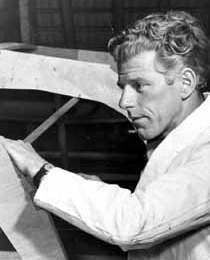About
Heron History
|
Jack Holt, legendary English designer of the Heron The Heron one class design dinghy Herons are an exciting sailing dinghy of 3.5m (11'3'') for crew of two designed by Jack Holt who also designed the Mirror, GP14, Star and others. The simple gunter rig (mast, gaff and boom) along with the elegant lines, modest size, good handling, robust construction and low cost have made Holt's 1950's Yachting World design one of the most popular dinghy classes ever. Sailed by parent / child, grandparents, youths or couples, Herons are highly regarded as an ideal first boat for taking up dinghy sailing. Herons are stable and easy to sail but also cater for the expert sailor with high level competition in boats of the one type. Herons are constructed in both timber and fibreglass and are able to be constructed at home from plans or purchased complete from authorised boat builders. Over 5,000 Herons have been made in Australia. A stitch and glue design has also been approved by the National Heron Sailing Association of Australia (NHSAA). It is hoped that this will encourage new timber boats to be constructed by amateur home builders (in approximately 90 hours). The Heron is a one class design and is regulated by a set of measurements and criteria issued by the NHSAA. This means that Herons are constructed, rigged and similarly equipped , therefore lowering the cost of ownership. This also focusses the skill onto the sailor, rather than on high-tech equipment. All boats complying with national measurement standards (and whose owners are Heron Association Members) are issued with an "A class" certificate allowing the boat to compete at a National Titles. "A class" boats are always sought after as they are set up to comply with current racing requirements and are usually in kept at a high maintenance standard with new (or near) new sails. Herons are normally carried on a small road trailer. The unique Heron trailer design (previously made in wood!) also allows for one adult to load and unload the boat via a swivelling skeg holder. The boat is towed backwards to achieve this, much to the amusement of other drivers. |

